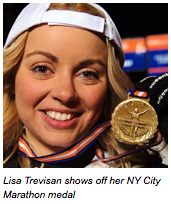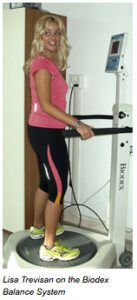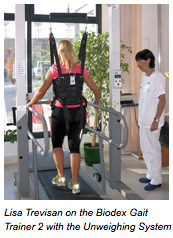New York City – Five years ago, 23 year old Italian model Lisa Trevisan collapsed on the dance floor of a disco in Venice, and woke from a coma 25 days later, paralyzed and unable to speak more than three words – “Si,” “No,” and “Miami” – the city where she studied English the previous summer. Slowly, she came to understand she had suffered a massive stroke of a variety that usually leaves victims permanently disabled.
 But on Sunday, November 2, 2008 this once-paralyzed stroke survivor now known throughout Italy by her pen name, “Lisa Festa,” crossed the finish line of the New York City Marathon, and celebrated her victory over a condition that once threatened to keep her wheelchair bound and speechless for life. Her completion of the marathon is a testimonial to her indomitable spirit – and her hard work in an Italian clinic equipped with state-of-the-art computerized rehabilitation systems developed in the U.S. and Switzerland.
But on Sunday, November 2, 2008 this once-paralyzed stroke survivor now known throughout Italy by her pen name, “Lisa Festa,” crossed the finish line of the New York City Marathon, and celebrated her victory over a condition that once threatened to keep her wheelchair bound and speechless for life. Her completion of the marathon is a testimonial to her indomitable spirit – and her hard work in an Italian clinic equipped with state-of-the-art computerized rehabilitation systems developed in the U.S. and Switzerland.
Before Lisa’s injured brain could move her paralyzed right leg, she took her first steps in a Swiss robotic gait trainer called a Lokomat that minimized her body weight and moved her legs in an organized fashion. Once the Lokomat helped her to take her first measured steps, she used a quartet of instruments developed on Long Island by Biodex Medical Systems – beginning with its Unweighing System that enabled her to pivot her hips as she walked on a Biodex Gait Trainer treadmill that encouraged her with every step to walk in a precise manner few stroke patients ever achieve. She used a Biodex Multi-Joint System to gradually strengthen her stroke-weakened leg, after which she recovered her leg-to-leg weight shifting and balance skills on a Biodex Balance System.
After five months of daily walking, then jogging, Lisa began preparing for a challenge few could have imagined: The New York Marathon. She crossed the finish line at 7 hours, 54 minutes – faster than many runners without disabilities.
Lisa’s Stroke – much more severe than those of most elderly
The condition known as a stroke actually describes a variety of events, all of which deprive an area of the brain of oxygenated blood. Most strokes occur in the elderly, commonly the result of prolonged, untreated high blood pressure, or blockage due to buildup of the same blood lipids responsible for most heart attacks. And as in heart attacks, the tissue served by blocked or ruptured blood vessels quickly “infarcts”-dies.
“When I awoke from my coma, I was unable to move my right arm or leg,” Lisa recalls, “and while I could understand what was said to me, I couldn’t find the words to respond. I could speak only ‘Si’ (yes), ‘No’ and ‘Miami’.”
After two months at Vicenza Hospital where she was admitted immediately after her stroke, Lisa was transferred to the University of Ferrara’s San Giorgio Hospital, renowned for rehabilitating individuals who’ve suffered especially severe strokes, like Lisa’s. It was the beginning of six months of steady hard work there.
“Lisa suffered a left cerebral infarction as a result of a complete occlusion of left middle cerebral artery,” explains neurologist Nino Basaglia, director of rehabilitation medicine at San Giorgio Hospital, and one of Europe’s best-known stroke specialists. “She was unable to walk or speak, and when standing, could not apply more than 30% of her body weight to her affected right leg. She wasn’t able to use her right arm due to spasticity of her forearm and hand.”
Dr. Basaglia determined that Lisa’s stroke most likely occurred as the result of a small hole between the right and left upper chambers (atria) of her heart, called a “patent foramen ovale.” It allowed a clot to form and travel to her brain, blocking one of her brain’s most important blood vessels that serve the region of her brain that controls muscles on the right side of her body, and the language processing centers.
“The objectives of her treatment were prevention of secondary lesions (conditions that might cause a second stroke), training for recovery of movement of her right upper and lower limbs, strengthening of paretic (paralyzed) muscles, focal treatment of spasticity, and walking with reduced weight on a special Biodex treadmill,” Dr. Basaglia said.
This past January, her doctors at San Giorgio decided Lisa had recovered sufficiently to undergo surgical closure of the hole between her heart chambers, significantly reducing the risk of a second stroke.
Lisa’s determination plays major role in recovery
Despite the support of top doctors and access to the latest in rehab technology, the single most important factor in Lisa’s recovery was her steely, good-humored determination to recover all her stroke-affected faculties.
 “I never doubted that I would walk again, but I was very concerned I might not speak,” Lisa explains. “I worked every day for two years, many hours, to relearn Italian.”
“I never doubted that I would walk again, but I was very concerned I might not speak,” Lisa explains. “I worked every day for two years, many hours, to relearn Italian.”
When she first tried to walk, Lisa recalls that her leg felt heavy, and she experienced painful muscle spasms, as a result of the “short circuits” in her brain resulting from her stroke. It was difficult just to stand, because the stroke also impacted her blood pressure control when she stood up. The “natural” instinct of an individual who’s suffered a stroke is to take a step with the unaffected leg, and then, to rotate their hip forward on the affected side, swinging the paralyzed leg in a semi-circle, so the toes and heel can clear the ground without bending the knee. Those who develop this abnormal gait rarely can walk very far. Lisa was determined to learn to walk so smoothly that no one might guess her past.
Early in her rehabilitation, Lisa recognized that her experience and battle might inspire others facing similar challenges. And so, she began making notes on her impressions and efforts, the people she met – patients and clinicians – and wrote a book titled “Si, No, Miami” that has been received to critical acclaim in Italy. The book is widely read by Italian secondary-school studies, and used as the basis for discussing the concept of overcoming life obstacles.
She is now writing a second book, “Si, Si, New York” telling of her efforts to go beyond the one hundred meters believed taxing for most stroke survivors to marathon-length distances. She currently seeks an English-language publisher.
Contact:
Lila Corwin
Vice President, Marketing Communications
Biodex Medical Systems, Inc.
20 Ramsey Road
Shirley, NY 11967
631-924-9000 , ext. 2281
lcorwin@biodex.com
www.biodex.com